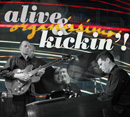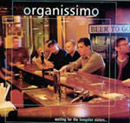Review - The Leslie 3300
by Jim Alfredson
Hammond Suzuki's latest Leslie speaker is a high-powered, compact, true dual-rotor monster capable of beautifully loud yet balanced tones. But does the small cabinet size reveal weaknesses?
HISTORY
What is the Hammond organ without a Leslie speaker? The two have been linked together for so long that most people are unaware of the less than hospitable history between the companies and their founders. Legend has it that Don Leslie originally submitted his idea of a rotating speaker to Laurens Hammond, as an alternative to Hammond's own underpowered stationary cabinets. Mr. Hammond, an accomplished inventor with an ego to match, rejected the idea that any speaker design could be better than his own. So, Leslie began his own company and his speakers quickly became the default partner for the Hammond organ, much to Hammond's dismay. In fact, at one point Hammond forbid his dealers to place Leslie speakers next to the Hammonds in their sales rooms. But customers knew what they wanted and the Leslie speaker became a huge hit and a lifelong partner to the Hammond organ, despite Mr. Hammond's objections.
After Laurens Hammond's death in 1973, the Hammond Organ Co. eventually bought the Leslie name. Today both names are owned by Suzuki Musical Instruments of Japan. They continue to produce modern incarnations of the classic instruments and speakers that the Hammond and Leslie names are known for, including digital re-creations of the Hammond B3 and new versions of the venerable Leslie 122 speaker.
SPECS
The Leslie 3300 is Hammond-Suzuki's attempt to go portable with a classic dual-rotor Leslie design. It is aimed squarely at the professional gigging musician. It is half the size of the 122 & 147 type cabinets and features an impressive 300 watt solid-state amplifier. 80 of those watts go to the ferro-fluid cooled horn driver. The horn driver is Hammond-Suzuki's own design and is rated at 100 watts, so no worries about driver failure*, unlike the old V21 Jensen drivers in the tube Leslies of the past. 220 watts go to the 15" woofer manufactured specifically for Hammond by Eminence.
The Leslie 3300 weighs 125lbs, about 30lbs less than a standard 122. It is 24.8 inches wide by 20.5 inches deep by 35.4 inches tall, making it one of the smallest and lightest dual-rotor cabinets ever designed for the Hammond organ under the Leslie name. It has a real rotating horn with baffles and a real rotating drum, made from very sturdy styrofoam. It also has built-in locking casters on the bottom for easy transport and placement.
The 3300 features an 11-pin Leslie input for quick connection to Hammond-Suzuki's modern digital organs including the XK3, XK3c, XK2, XB2, XB5, the New B3 and C3, the B-3P, and the B-3M. It also has an 8-pin Leslie input for older models like the XB-1, XK1, XM-1, and XM-2. And not to be forgotten, a 1/4" input for direct connection of any synthesizer or guitar or any other source with a standard 1/4" output.
Fig 1.0 - The 3300's panel controls (click image for larger version)
Although the 3300's amplification is solid-state, it has a tube-based preamplifier section. The tube portion of the preamp can be switched on or off via the control panel (see Fig 1.0). The panel controls on the 3300 include the combination switch / volume knob to turn on or off the tube preamp section and control the drive level of the tube. Next is the overall volume knob, a tube mode knob (soft to hard), bass, midrange, and treble contols, a separate volume control for the level of the horn (very handy!), and a sub output control and sub output 1/4" jack. This last addition proves to be critical for those of us who kick bass on the organ. More on that later.
*see addedum, page 4





